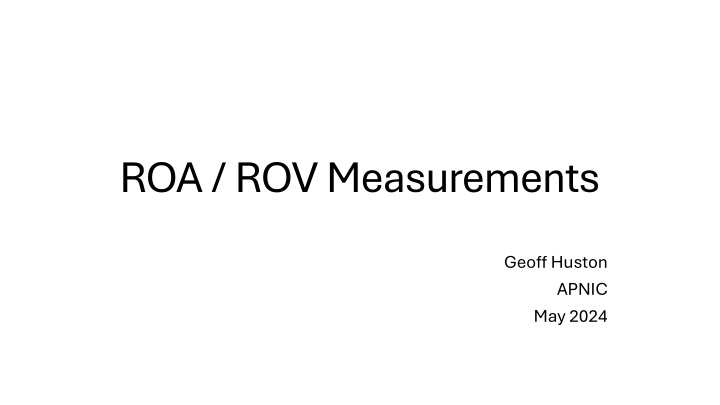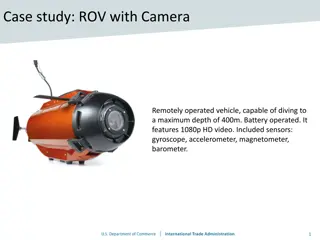
ROA and ROV Measurements Report May 2024
Explore the latest ROA and ROV measurements by Geoff Huston from APNIC in May 2024. Discover the deployment status, IPv4 and IPv6 route object proportions with associated RPKI ROAs, where ROAs are deployed, and insights into the I-ROV route drop and ISP filtering behaviors. The report indicates a positive state of ROA publication and deployment across various regions globally.
Download Presentation

Please find below an Image/Link to download the presentation.
The content on the website is provided AS IS for your information and personal use only. It may not be sold, licensed, or shared on other websites without obtaining consent from the author. If you encounter any issues during the download, it is possible that the publisher has removed the file from their server.
You are allowed to download the files provided on this website for personal or commercial use, subject to the condition that they are used lawfully. All files are the property of their respective owners.
The content on the website is provided AS IS for your information and personal use only. It may not be sold, licensed, or shared on other websites without obtaining consent from the author.
E N D
Presentation Transcript
ROA / ROV Measurements Geoff Huston APNIC May 2024
Time Series IPv4 Proportion of IPv4 route objects that have an associated RPKI ROA
Time Series IPv6 Proportion of IPv6 route objects that have an associated RPKI ROA
Where are we with ROA publication? And the answer is that we appear to be in a surprisingly good place! ROAs have been extensively deployed across much of Europe, the Middle East, Asia and South America The RPKI publication system appears to be adequately robust, although there is a very high level of reliance on the RPKI publication services operated by the RIRs
Measuring I-ROV Route Drop Proportion of end users that CANNOT access an object that lies behind an invalid route
Measuring I-ROV Route Drop In this measurement we use an invalid destination advertised by a CDN (Cloudflare) We do this to minimize the effects of transit networks masking the ROV behaviour of stub networks We then use an online ad campaign to enroll ~10M endpoints to reach this destination per day The measurement is the proportion of endpoints who cannot reach the invalid destination
Many networks sign ROAS, but fewer perform I-ROV Filtering For Example - Saudi Arabia I-ROV Filtering - 0% ROA Signing - 90%
Unfinished Routing Security Work Validated Origination without AS Path protection is ineffectual against determined attack It is useful against inadvertent route leaks, but a determined attacker can forge a AS Path that reflects correct origination BGPSEC (RFC8205) can protect the AS Path, but the cost of deployment appears to be too high - deployment of BGPSEC has not gathered momentum, and it s unlikely to ever do so! ASPA provides a weaker form of Path protection but there is no sign of operational uptake The draft specification is still in the IETF process after ~7 years
Is all this helping? This is a hard question to answer with measurements Preventative technologies are all about the absence And its always hard to measure what s NOT happening! I m not sure we understand how we can take a fully distributed system such as inter-domain routing and impose an overlay of credentials and constraints that completely prevents all forms of aberrant behaviours But we can make it harder to abuse the routing system, either through inadvertent lapses or through deliberate intent And the RPKI / ROV framework is our best effort to improve the security and integrity of the routing system It s not a panacea and routing vulnerabilities still exist in many ways and many forms but it can help the overall picture of routing resilience absence of behaviours






















